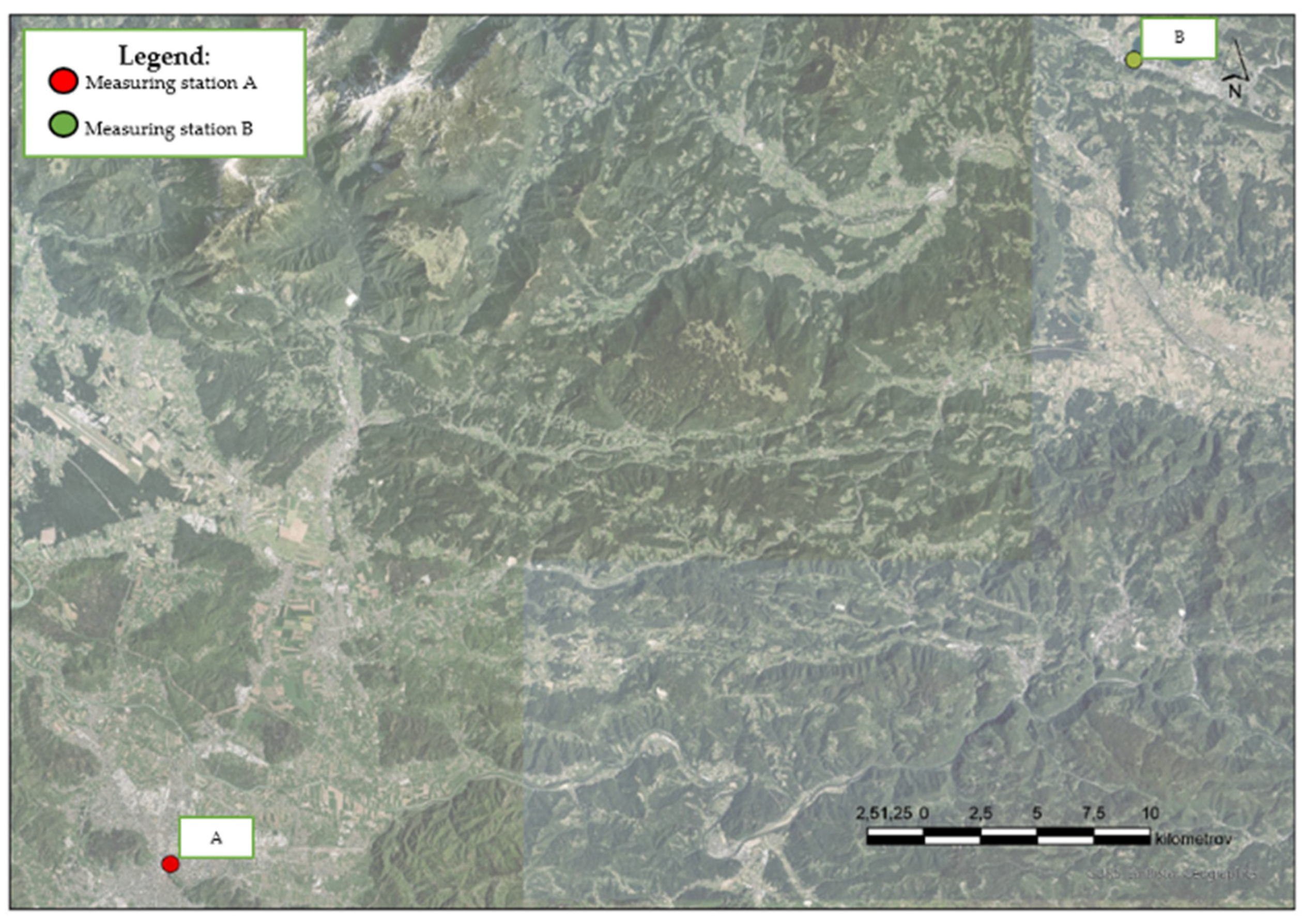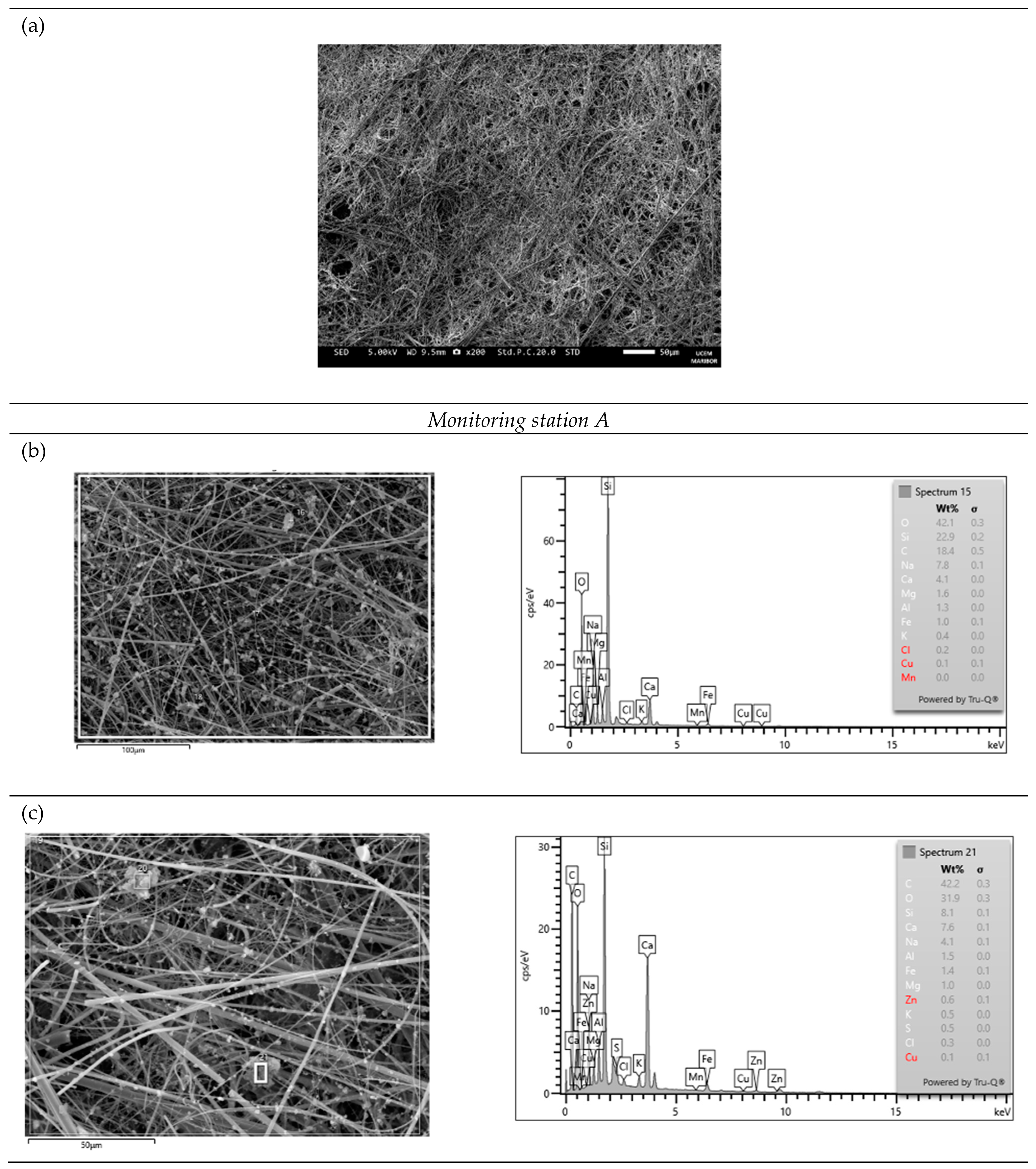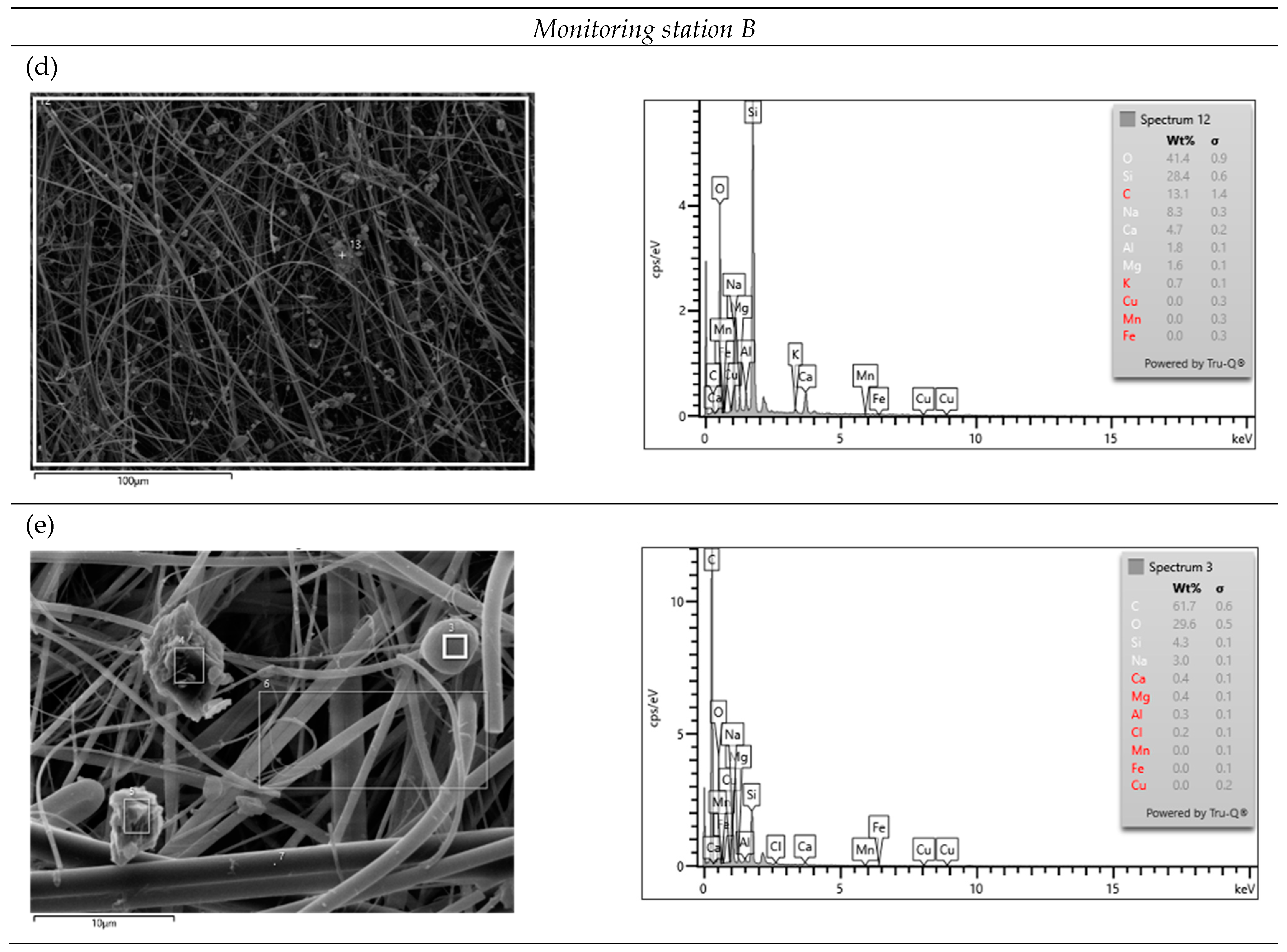Spatiotemporal Analysis and Physicochemical Profiling of PM10 and PM2.5 in Slovenia
Abstract
1. Introduction
2. Materials and Methods
2.1. Study Area
2.2. Site Selection
2.3. PM Sampling
2.4. SEM-EDS Analysis
2.5. Statistical Analysis
3. Results and Discussion
3.1. PM10 Concentrations Through the Years
3.2. PM2.5 Concentrations Through the Years
3.3. Analysis of Annual PM10 and PM2.5 Concentrations at Monitoring Station A and Monitoring Station B
3.4. Correlations Between PM10 and PM2.5: Seasonal Variability and Influencing Factors
3.5. Meteorological Conditions Through the Years
3.6. Elemental Composition and Morphological Characteristics of PM Analyzed by SEM-EDS
4. Conclusions
Author Contributions
Funding
Institutional Review Board Statement
Informed Consent Statement
Data Availability Statement
Conflicts of Interest
Abbreviations
| AAS | Atomic Absorption Spectroscopy |
| ARSO | Slovenian Environment Agency |
| COPD | Chronic obstructive pulmonary disease |
| EEA | European Environment Agency |
| EU | European Union |
| EIMV | Elektroinštitut Milan Vidmar |
| FE-SEM | Field Emission Scanning Electron Microscopy |
| FT-IR | Fourier Transform Infrared Spectroscopy |
| ICP-OES | Inductively Coupled Plasma Optical Emission Spectroscopy |
| ICP-MS | Inductively Coupled Plasma Mass Spectroscopy |
| Pp | Precipitation |
| PM | Particulate matter |
| RHp | Relative humidity |
| SEM-EDS | Scanning Electron Microscopy with Energy-Dispersive Spectroscopy |
| SEM-EDX | Scanning Electron Microscopy with Energy-Dispersive X-ray Spectroscopy |
| SURS | Slovenian Statistical Biro |
| Tp | Temperature |
| VOCs | Volatile organic compounds |
| XRD | X-ray Diffraction |
| WHO | World Health Organization |
| WSp | Wind speed |
References
- Kumar, N.; Hamzah, F.M.; Diantoro, M.; Muhd Zailani, N.A. Suman Physiochemical characterization of ambient PM10 and PM2.5 in an urban environment. Curr. Appl. Phys. 2025, 71, 57–69. [Google Scholar] [CrossRef]
- Gal, O.; Eitan, O.; Rachum, A.; Weinberg, M.; Zigdon, D.; Assa, R.; Price, C.; Yovel, Y. Air Pollution likely reduces hemoglobin levels in urban fruit-bats. iScience 2025, 28, 111997. [Google Scholar] [CrossRef] [PubMed]
- World Helath Organization (WHO). WHO Global Air Quality Guidelines; Update 2021; WHO: Geneva, Switzerland, 2021. [Google Scholar]
- Air Quality Directive. 2024. Available online: https://www.consilium.europa.eu/sl/press/press-releases/2024/10/14/air-quality-council-gives-final-green-light-to-strengthen-standards-in-the-eu/ (accessed on 10 March 2025).
- Lavrič, P.D.; Ivanovski, M.; Goričanec, D.; Urbancl, D. Particulate Matter Air Pollution in the Republic of Slovenia and Its National Spatial Emissions Release. Available online: https://revue.cder.dz/index.php/rer/article/view/1149 (accessed on 10 March 2025).
- Moghimi Dehkordi, M.; Pournuroz Nodeh, Z.; Soleimani Dehkordi, K.; Salmanvandi, H.; Rasouli Khorjestan, R.; Ghaffarzadeh, M. Soil, air, and water pollution from mining and industrial activities: Sources of pollution, environmental impacts, and prevention and control methods. Results Eng. 2024, 23, 102729. [Google Scholar] [CrossRef]
- Bakirci, M. Evaluating the impact of unmanned aerial vehicles (UAVs) on air quality management in smart cities: A comprehensive analysis of transportation-related pollution. Comput. Electr. Eng. 2024, 119, 109556. [Google Scholar] [CrossRef]
- Dong, D.; Wang, J. Air pollution as a substantial threat to the improvement of agricultural total factor productivity: Global evidence. Environ. Int. 2023, 173, 107842. [Google Scholar] [CrossRef]
- Manzueta, R.; Kumar, P.; Ariño, A.H.; Martín-Gómez, C. Strategies to reduce air pollution emissions from urban residential buildings. Sci. Total Environ. 2024, 951, 175809. [Google Scholar] [CrossRef]
- Abhijith, K.V.; Kumar, P.; Omidvarborna, H.; Emygdio, A.P.M.; McCallan, B.; Carpenter-Lomax, D. Improving air pollution awareness of the general public through citizen science approach. Sustain. Horiz. 2024, 10, 100086. [Google Scholar] [CrossRef]
- Brauer, M.; Casadei, B.; Harrington, R.A.; Kovacs, R.; Sliwa, K. Taking a Stand Against Air Pollution—The Impact on Cardiovascular Disease: A Joint Opinion from the World Heart Federation, American College of Cardiology, American Heart Association, and the European Society of Cardiology. J. Am. Coll. Cardiol. 2021, 77, 1684–1688. [Google Scholar] [CrossRef]
- Kelly, F.J.; Fussell, J.C. Air pollution and public health: Emerging hazards and improved understanding of risk. Environ. Geochem. Health 2015, 37, 631–649. [Google Scholar] [CrossRef]
- Kyung, S.Y.; Jeong, S.H. Particulate-Matter Related Respiratory Diseases. Tuberc. Respir. Dis. 2020, 83, 116–121. [Google Scholar] [CrossRef]
- Stump, Á.; Szabó-morvai, Á. Journal of Environmental Economics and The effect of air pollution on fertility in 657 European regions. J. Environ. Econ. Manage. 2025, 130, 103111. [Google Scholar] [CrossRef]
- Sampath, V.; Aguilera, J.; Prunicki, M.; Nadeau, K.C. Mechanisms of climate change and related air pollution on the immune system leading to allergic disease and asthma. Semin. Immunol. 2023, 67, 101765. [Google Scholar] [CrossRef] [PubMed]
- Hrženjak, V.V.; Kukec, A.; Eržen, I.; Stanimirović, D. Effects of ultrafine particles in ambient air on primary health care consultations for diabetes in children and elderly population in ljubljana, Slovenia: A 5-year time-trend study. Int. J. Environ. Res. Public Health 2020, 17, 4970. [Google Scholar] [CrossRef] [PubMed]
- Dao, X.; Di, S.; Zhang, X.; Gao, P.; Wang, L.; Yan, L.; Tang, G.; He, L.; Krafft, T.; Zhang, F. Composition and sources of particulate matter in the Beijing-Tianjin-Hebei region and its surrounding areas during the heating season. Chemosphere 2022, 291, 132779. [Google Scholar] [CrossRef]
- Talbi, A.; Kerchich, Y.; Kerbachi, R.; Boughedaoui, M. Assessment of annual air pollution levels with PM1, PM2.5, PM10 and associated heavy metals in Algiers, Algeria. Environ. Pollut. 2018, 232, 252–263. [Google Scholar] [CrossRef]
- ARSO. Kakovost Zraka v Sloveniji v Letu 2023. 2024. Available online: http://hmljn.arso.gov.si/zrak/kakovostzraka/poročilainpublikacije/porocilo_2023-FINAL.pdf (accessed on 12 March 2025).
- Afifa, K.; Arshad, N.; Hussain, N.; Ashraf, M.H.; Saleem, M.Z. Air pollution and climate change as grand challenges to sustainability. Sci. Total Environ. 2024, 928, 172370. [Google Scholar] [CrossRef]
- Mohammed, G.; Karani, G.; Mitchell, D. Trace Elemental Composition in PM10 and PM2.5 Collected in Cardiff, Wales. Energy Procedia 2017, 111, 540–547. [Google Scholar] [CrossRef]
- Ramirez-Leal, R.; Valle-Martinez, M.; Cruz-Campas, M. Chemical and Morphological Study of PM10 Analysed by SEM-EDS. Open J. Air Pollut. 2014, 03, 121–129. [Google Scholar] [CrossRef]
- Sinha, A.; Ischia, G.; Straffelini, G.; Gialanella, S. A new sample preparation protocol for SEM and TEM particulate matter analysis. Ultramicroscopy 2021, 230, 113365. [Google Scholar] [CrossRef]
- Li, D.; Yue, W.; Gong, T.; Gao, P.; Zhang, T.; Luo, Y.; Wang, C. A comprehensive SERS, SEM and EDX study of individual atmospheric PM2.5 particles in Chengdu, China. Sci. Total Environ. 2023, 883, 163668. [Google Scholar] [CrossRef]
- Kukec, A.; Jereb, G.; Zaletel-Kragelj, L.; Farkaš-Lainščak, J.; Bizjak, M.; Eržen, I. Special Edition 2014 Kakovost zunanjega zraka kot determinanta zdravja. Int. J. Sanit. Eng. Res. 2014, 4. [Google Scholar]
- Dolšak Lavrič, P.; Ivanovski, M.; Vončina, R. Poročilo o Meritvah Kakovosti Zraka AMP Agenciji Republike Slovenije za Okolje, Leto 2020; Inštitut za elektrogospodarstvo in elektroindustrijo: Ljubljana, Slovenia, 2020; Available online: https://www.okolje.info/index.php/porocila-moc (accessed on 10 March 2025).
- Glojek, K.; Dinh Ngoc Thuy, V.; Weber, S.; Uzu, G.; Manousakas, M.; Elazzouzi, R.; Džepina, K.; Darfeuil, S.; Ginot, P.; Jaffrezo, J.L.; et al. Annual variation of source contributions to PM10 and oxidative potential in a mountainous area with traffic, biomass burning, cement-plant and biogenic influences. Environ. Int. 2024, 189, 108787. [Google Scholar] [CrossRef] [PubMed]
- Network, C.B. Air Pollution in the Balkans—Independent Monitoring. 2025. Available online: https://bankwatch.org/beyond-fossil-fuels/airpollution-balkans?utm_source (accessed on 12 March 2025).
- Ziernicka-Wojtaszek, A.; Zuśka, Z.; Kopcińska, J. Assessment of the Effect of Meteorological Conditions on the Concentration of Suspended PM2.5 Particulate Matter in Central Europe. Sustainability 2024, 16, 4797. [Google Scholar] [CrossRef]
- Ivanovski, M.; Lavrič, P.D.; Vončina, R.; Goričanec, D.; Urbancl, D. Improvement of Air Quality During the COVID-19 Lockdowns in the Republic of Slovenia and Its Connection with Meteorology. Aerosol Air Qual. Res. 2022, 22. [Google Scholar] [CrossRef]
- Ivanovski, M.; Alatič, K.; Urbancl, D.; Simonič, M.; Goričanec, D.; Vončina, R. Assessment of Air Pollution in Different Areas (Urban, Suburban, and Rural) in Slovenia from 2017 to 2021. Atmosphere 2023, 14, 578. [Google Scholar] [CrossRef]
- ARSO. ARSO Arhiv Meteo. 2025. Available online: https://meteo.arso.gov.si/met/sl/archive/ (accessed on 12 March 2025).
- Agencija Republike Slovenije za Okolje. Kakovost Zraka v Sloveniji v Letu 2019. 2020. Available online: https://www.arso.gov.si/zrak/kakovostzraka/poročilainpublikacije/Letno_Porocilo_2019_Za_Splet.pdf (accessed on 12 March 2025).
- Gjerek, M.; Koleša, T.; Logar, M.; Matevž, L.; Murovec, M.; Rus, M.; Žabkar, R. Kakovost Zraka v Slovniji v Letu 2020; Agencija Republike Slovenije za okolje: Ljubljana, Slovenia, 2021. Available online: http://www.arso.gov.si/zrak/kakovostzraka/poročilainpublikaci-je/kakovost_letna.html (accessed on 12 March 2025).
- Bec, D.Ž.R.; Ciglenički, D.; Dolšak Lavrič, P.; Gjerek, M.; Koleša, T.; Logar, M.; Matavž, L.; Murovec, M.; Rus, M. Kakovost Zraka v Republiki Sloveniji v Letu 2021. 2022. Available online: https://www.arso.gov.si/zrak/kakovostzraka/poročilainpublikacije/Letno_porocilo_2021_Final.pdf (accessed on 12 March 2025).
- ARSO. Kakovost Zraka v Sloveniji v Letu 2022. 2022. Available online: https://okolje.arso.gov.si/zrak/kakovost%20zraka/poročila%20in%20publikacije/porocilo_2022_Merged.pdf (accessed on 12 March 2025).
- Wang, L.; Guan, Q.; Wang, F.; Yang, L.; Liu, Z. Association between heating seasons and criteria air pollutants in three provincial capitals in northern China: Spatiotemporal variation and sources contribution. Build. Environ. 2018, 132, 233–244. [Google Scholar] [CrossRef]
- European Environmental Agency (EEA). Europe’s Air Quality Status 2023. 2023. Available online: https://www.eea.europa.eu/publications/europes-air-quality-status-2023/europes-air-quality-status2023 (accessed on 12 March 2025).
- World Health Organization. Air Quality Guidelines. 2021. Available online: https://www.who.int/news-room/questions-and-answers/item/who-global-air-quality-guidelines (accessed on 12 March 2025).
- Ramirez-Leal, R.; Cruz-Campas, M.; Estuardo-Moreno, H. Characterization of PM10 Particles by SEM-EDS. Microsc. Microanal. 2018, 24, 1070–1071. [Google Scholar] [CrossRef]







| Sampling Site | Altitude (m) | D96_E 1 | D96_N 1 | Area Type | Measurement Type | Characteristics of Area |
|---|---|---|---|---|---|---|
| A | 299 | 504,134 | 137,503 | Urban | Traffic | Residential, commercial |
| B | 362 | 461,548 | 102,067 | Urban | Industrial | Residential, industrial |
| Monitoring Station | 2019 | 2020 | 2021 | 2022 |
|---|---|---|---|---|
| A | 0.95 (p = 0.045) | 0.99 (p = 0.020) | 0.98 (p = 0.010) | 0.95 (p = 0.030) |
| B | 0.92 (p = 0.070) | 0.87 (p = 0.040) | 1 (p = 0) | 0.92 (p = 0.020) |
| Monitoring Station A (Year) | 2019 | 2020 | 2021 | 2022 |
|---|---|---|---|---|
| Tp (°C) | 12.5 | 12.1 | 11.5 | 12.9 |
| RHp (%) | 74 | 71 | 72 | 69 |
| Pp (mm) | 1378.9 | 1262.2 | 1442.3 | 1264.3 |
| WSp (m/s) | 1.3 | 1.3 | 1.3 | 1.3 |
| Monitoring Station B (Year) | 2019 | 2020 | 2021 | 2022 |
|---|---|---|---|---|
| Tp (°C) | 10.2 | 9.5 | 8.9 | 10.1 |
| RHp (%) | 77 | 77 | 77 | 75 |
| Pp (mm) | 1226.7 | 1074.2 | 1083.6 | 836.6 |
| WSp (m/s) | 1.7 | 1.7 | 1.6 | 1.7 |
Disclaimer/Publisher’s Note: The statements, opinions and data contained in all publications are solely those of the individual author(s) and contributor(s) and not of MDPI and/or the editor(s). MDPI and/or the editor(s) disclaim responsibility for any injury to people or property resulting from any ideas, methods, instructions or products referred to in the content. |
© 2025 by the authors. Licensee MDPI, Basel, Switzerland. This article is an open access article distributed under the terms and conditions of the Creative Commons Attribution (CC BY) license (https://creativecommons.org/licenses/by/4.0/).
Share and Cite
Ivanovski, M.; Anžel, I.; Goričanec, D.; Urbancl, D. Spatiotemporal Analysis and Physicochemical Profiling of PM10 and PM2.5 in Slovenia. Atmosphere 2025, 16, 540. https://doi.org/10.3390/atmos16050540
Ivanovski M, Anžel I, Goričanec D, Urbancl D. Spatiotemporal Analysis and Physicochemical Profiling of PM10 and PM2.5 in Slovenia. Atmosphere. 2025; 16(5):540. https://doi.org/10.3390/atmos16050540
Chicago/Turabian StyleIvanovski, Maja, Ivan Anžel, Darko Goričanec, and Danijela Urbancl. 2025. "Spatiotemporal Analysis and Physicochemical Profiling of PM10 and PM2.5 in Slovenia" Atmosphere 16, no. 5: 540. https://doi.org/10.3390/atmos16050540
APA StyleIvanovski, M., Anžel, I., Goričanec, D., & Urbancl, D. (2025). Spatiotemporal Analysis and Physicochemical Profiling of PM10 and PM2.5 in Slovenia. Atmosphere, 16(5), 540. https://doi.org/10.3390/atmos16050540





